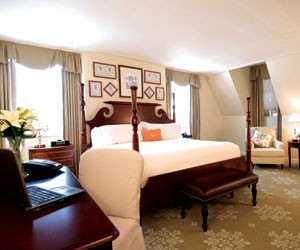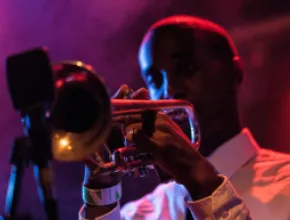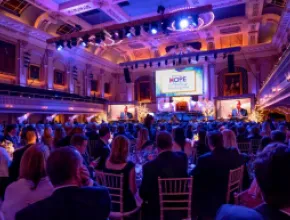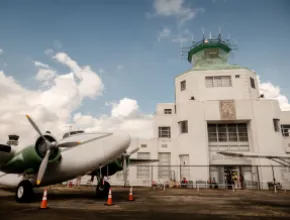Perhaps nothing best evokes the romance of travel than a vintage train—unless, that is, it's a vintage ship, airplane or automobile.
Transportation-themed historical venues appeal not only to travel junkies and history buffs, however. They also appeal to those dazzled by Hollywood glamour, as vintage vehicles frequently star as props in movies; as well as to tinkerers fascinated by the inner-workings of fantastic machines.
Whether they are conventional museums or portable pieces of history, transportation-themed historical venues solve at least two major problems meeting planners usually face when creating special events: how to keep attendees entertained and how to create a dramatic environment.
"Wandering around the museum becomes the major activity and entertainment, and viewing the equipment initiates conversations among guests who don't know each other—it's a great mixer," says Jill Wilson, principal of Jill Wilson Studio, in Orinda, Calif., who has produced transportation-themed events throughout the West for financial services groups.
"The featured equipment also becomes the room decor, so there is usually no need to enhance the environment with costly prop rentals," she adds.
Museum of Flight
With its towering glass ceilings and views of the city skyline and Mount Rainier, Seattle's Museum of Flight is by itself a dramatic venue for events. But add in more than 90 aircraft and space vehicles combined and it's no wonder that the museum so easily attracts groups.
"We deal with a lot of international groups, and they love this venue—it's a crowd-pleaser," says Carol Riddle, a national account executive at SH Worldwide, an event planning company, in Seattle.
The 141,000-square-foot venue is so popular with groups that SH Worldwide produces about 10 events a year there for the likes of Microsoft, Boeing and the American Health Lawyers Association.
Among other treasures, the museum houses the only remaining M-21 Blackbird spy plane; the Air Force One used by presidents Eisenhower, Kennedy, Johnson, and Nixon; and the first Boeing 747.
For hands-on experiences, the museum offers the Aviation Learning Center, where attendees can simulate flight; and the Challenger Learning Center for those who set their sights on a mission to Mars or the moon. In addition, the museum's Amazing Skies theater troupe will mingle with attendees or stage aviation-themed performances.
In July, the museum's new glass-enclosed, 15,500-square-foot Space Gallery will open, featuring a retired NASA training simulator.
"The venue is so versatile because of all the different size rooms and galleries," Riddle says. "A board of directors dinner for 30 people up to a full convention reception for a few thousand works marvelously."
Durango & Silverton Narrow Gauge Railroad & Museum
Colorado's gold and silver prompted the Denver & Rio Grande Railroad to build a 45-mile, narrow-gauge line from Durango to Silverton in 1881to haul out the ore. But the rail executives quickly discovered that hauling passengers through the classic Rocky Mountain scenery provided more enduring riches.
A National Historic Landmark, the Durango & Silverton Narrow Gauge Railroad is one of the oldest continuously operating railroad lines in the U.S. It has played starring roles in such movie Westerns as How the West Was Won and Butch Cassidy and the Sundance Kid.
Coal-fired locomotives built in the 1920s pull the train, which features eight authentic, Victorian-era cars as well as replicas of vintage cars. Meeting planners can charter an entire train for groups from 80 to 400 attendees, with individual coaches available for groups of 16 to 40 people.
Joanie Fraughton, executive director of the Durango Independent Film Festival, has organized a train ride for a group of filmmakers as well as a fund-raiser at the 12,000-square-foot museum, in Durango.
"The landscape is varied, and it's very dramatic," Fraughton says of the train route. "There are spots where the train hugs the mountainside, and you look down 300 feet to the river below."
The museum accommodates groups ranging from 20 to 250 attendees. It houses a locomotive built in 1887, vintage rail cars, exhibits of railroad artifacts like tools and lanterns, photographs and paintings and a large library of railroad history books.
National Automobile Museum
William F. Harrah is best remembered as a pioneer of Nevada gaming, having founded Harrah's Hotels and Casinos. But he was also renowned as a car collector, amassing some 1,400 automobiles by the time he died in 1975.
A choice selection of Harrah's cars now resides at the National Automobile Museum (The Harrah Collection), located by the Truckee River in downtown Reno amid the city's major casino hotels. The 105,000-square-foot museum contains more than 200 vintage automobiles, one of the country's most comprehensive car collections. Among the many rare autos on display is an 1892 Philion, which is one of the oldest existing American-built cars, and singer Al Jolson's 1933 Cadillac All-Weather Phaeton.
Four street scenes—complete with building facades, autos and other historical artifacts—each represent one-quarter of the 20th century, providing ready-made settings for events. The museum also features an automotive shop and a 157-seat theater. Costumed docents are available to explain the exhibits to attendees in addition to individual digital audio players.
The museum can accommodate from 20 to 1,500 attendees. For a group of 80 attendees last September, Jill Wilson, of Jill Wilson Studio, used a then-current exhibit with a national parks theme as the setting for a seated dinner.
"I placed the dinner tables very close to the exhibit so that the guests felt they were camping in a national park among vintage camping vehicles," she says. "I also added antique picnic baskets as centerpieces."
USS POTOMAC
The USS Potomac has enjoyed—or perhaps more accurately, endured—a long and colorful history from the time it served as President Franklin Delano Roosevelt's unofficial floating White House until its present life as a tour boat berthed at Jack London Square in Oakland, Calif.
Built in 1934 as a Coast Guard cutter, the 165-foot-long vessel was pressed into FDR's service less than two years later. After Roosevelt's death in 1945, the Potomac passed to different owners, serving at one point as a ferry between Puerto Rico and the Virgin Islands. In 1964, none other than Elvis Presley bought the yacht for a bargain-basement price and donated it to a Memphis hospital for a fundraiser.
By 1980, the Potomac had fallen into the hands of drug smugglers and was seized in San Francisco Bay by federal authorities. The yacht soon sank but was quickly resurrected and sold at scrap prices to the Port of Oakland.
After undergoing a major restoration, the yacht is now owned and operated by the nonprofit Potomac Association for bay cruises and dockside tours. A National Historic Landmark, the Potomac can accommodate up to 120 attendees for either cruises or dockside events.
Xantrion, an information technology services company, in Oakland, has held two customer-and-employee appreciation events on the Potomac over the past few years, each a cruise for about 70 attendees.
"We chose the Potomac because of its unique history," Xantrion CEO Anne Bisagno says. "Guests really loved the bay tour and photos ops."
San Francisco Historic Streetcars and Railway Museum
Thanks to singer Tony Bennett and his signature song, I Left My Heart in San Francisco, the whole world knows about the city's cable cars. Lesser known but no less impressive is its collection of more than 40 historical streetcars.
The city's vintage streetcars, also called trolleys, commonly ply the F-Line on the Embarcadero along San Francisco Bay and Market Street adorned in flashy color schemes that suggest a parade.
They range from one of San Francisco's first generation of electric streetcars, built in 1895, to one that resembles a boat on wheels and was built in 1934 for service in the English seaside resort of Blackpool. The fleet's more typical streetcars—sleek streamliners recalling Art Deco designs—each can accommodate 40 to 50 people, depending on car size.
Groups can take chartered streetcars on public trolley tracks throughout the city, not just on the F-Line.
The San Francisco Railway Museum, a stop on the F-Line, is convenient for an event that combines a trolley ride with a reception at the 1000-square-foot venue, which can accommodate up to 45 people.
Marshall Krantz has been a writer and editor for meetings industry publications for over 15 years.






